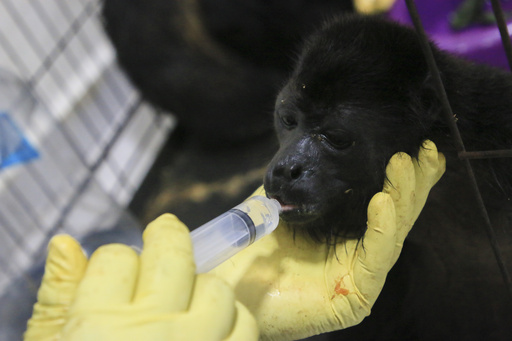MEXICO CITY (AP) — The number of heat-related howler monkeys deaths in Mexico has risen to 157, the government said, with a tragically small number of the primates treated or recovering.
Meanwhile, an animal park in northern Mexico confirmed it has received reports that at least a hundred parrots, bats and other animals have died, apparently of dehydration.
A heat dome — an area of strong high pressure centered over the southern Gulf of Mexico and northern Central America — has blocked clouds from forming and caused extensive sunshine and hot temperatures all across Mexico.
Last week, environmentalists had reported that 138 of the midsize primates, known for their roaring vocal calls, had been found dead in the Gulf coast state of Tabasco since May 16. Almost two-thirds of the country are expected to see highs of 45 degrees Celsius (113 degrees Fahrenheit) on Monday.
Late Sunday the Environment Department reported that number had risen to 157, and that research was continuing into the causes of the deaths.
Wildlife biologist Gilberto Pozo attributed the deaths to a heat stroke, noting a “synergy” of factors — including high heat, drought, forest fires and logging that deprives the monkeys of water, shade and the fruit they eat — appeared to be to blame, while saying a pathogen, disease or other factor can’t yet be ruled out.
The department said deaths were occurring in both Tabasco and the neighboring state of Chiapas, and that 13 monkeys were under treatment and seven had been treated and released back into their habitat. The department said some of the monkeys were being treated for dehydration, and that three were in serious but stable condition.
But with heat, fires, and deforestation hitting the trees where the howler monkeys live, it was unclear whether even releasing them could ensure their survival.
In the northern state of San Luis Potosi, Ena Buenfil, the director of the Selva Teenek eco-park, told The Associated Press on Monday that her facility has been overwhelmed as parrots, bats, toucans have died due to the heat.
Buenfil said when the heat wave began in mid-May their clinic to help animals quickly filled up with sick birds and they received a wave of reports by locals finding dead or suffering birds.
Because of scarce resources by authorities, Buenfil said the number is likely only a small percentage of the animals affected, but added that their organization has worked with Civil Protection to aid some birds.
Buenfil said birds mainly die of dehydration in the heat, and are often disproportionately affected because they don’t have anywhere to store water. Meanwhile, bats would become dehydrated sleeping in the beating afternoon heat. She recommended that locals put out bowls of water for animals.
“We’ve never seen a situation like what’s happening right now,” she said, adding if they see more heat peaks like this one “there is not going to be much we can do for the animals.”
“There are going to be a lot of casualties to the ecosystem if we continue this trend of heat waves in the region,” said Buenfil.
Normally quite intimidating, howler monkeys are muscular and some can be as tall as 90 centimeters (3 feet), with tails just as long. Some males weigh more than 13.5 kilograms (30 pounds) and can live up to 20 years. They are equipped with big jaws and a fearsome set of teeth and fangs. But mostly they’re know for their lion-like roars, which bely their size.
With below-average rainfall throughout almost all the country so far this year, lakes and dams are drying up, and water supplies are running out. Authorities have had to truck in water for everything from hospitals to fire-fighting teams. Low levels at hydroelectric dams have contributed to power blackouts in some parts of the country.
This website uses cookies so that we can provide you with the best user experience possible. Cookie information is stored in your browser and performs functions such as recognising you when you return to our website and helping our team to understand which sections of the website you find most interesting and useful.
